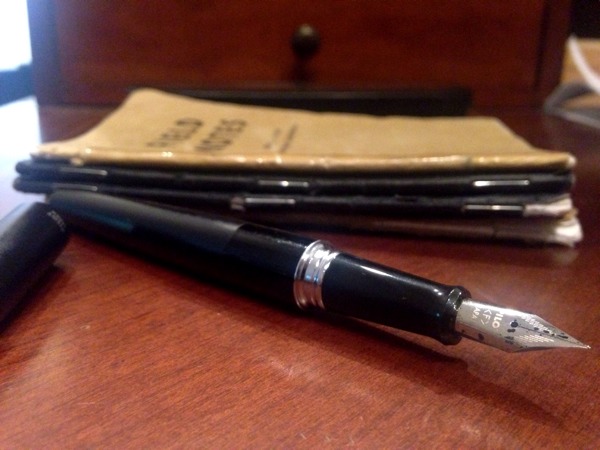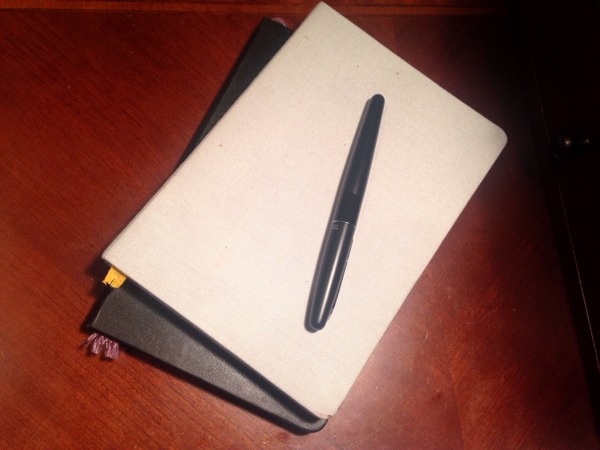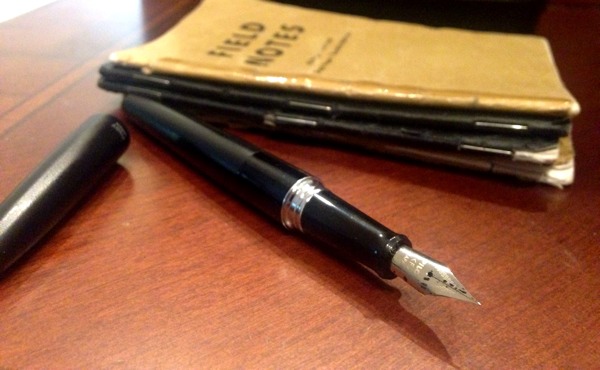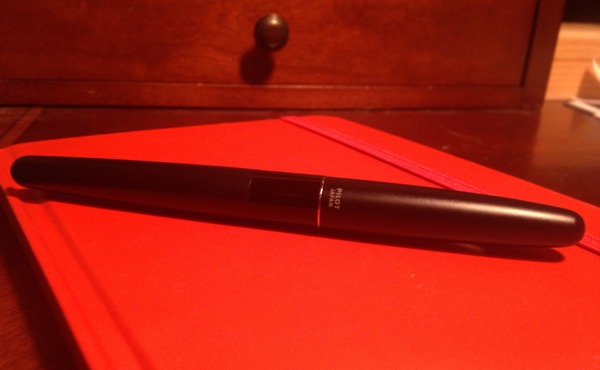Porridge Papers, an independently owned, local paper mill and letterpress studio in Lincoln, Nebraska.
Via: Locally Crafted
Porridge Papers, an independently owned, local paper mill and letterpress studio in Lincoln, Nebraska.
Via: Locally Crafted
Staedtler pigment liner and Moleskine notebook – Matt Gemmell
It’s my view that if you’re going to carry something through life with you, it should be the most beautiful and pleasurable object you can find. That applies to my phone, my laptop, my wristwatch and most definitely my notebooks and pens.
And, here is the other thing about this idea — A tool you love to have is a tool you will love to use. I could not constantly keep a daily journal for more than a few months at a stretch until I found one I really, really, loved to use.

Those of us who have used fountain pens for many years are often asked by those looking to jump in where to start. We pen folks always have a favorite recommendation or two. Unsurprisingly, most of us have the same ones. When I first reached out to my friends at Pen Chalet and asked them to send me a Pilot Metropolitan for review, it was because all I had read about it made it seem like it was the new gold standard in entry level fountain pens. Many reviewers I respected said it would become their new go-to recommendation. I wanted to see what all the fuss was about.

Let me state, up front, that the answer to that question is now abundantly clear. The Metropolitan is not just a great entry level pen. It is a really great pen full stop. In the time that I’ve had it, despite other long loved higher quality pens within reach, I found myself consistently reaching for it and being satisfied I made the right choice. While it is very nice, it still feels like a pen that wants to be used a lot.
In fact, I’m dumbfounded at how a pen so solid, well manufactured, attractively designed, and smooth writing can be delivered at this price point. It’s currently on sale for only $15.00 US at Pen Chalet (and normally retails for not much more). It feels wonderful in the hand — just the right size and weight.

The brass body with stainless steel accents are part of of what make it look far more expensive than it costs.

For ink, I decided to put myself in the shoes of a new fountain pen user and use the included black ink cartridge. That said, it does come with a squeeze converter installed so using ones favorite ink of choice is an option.

The one I have is a fine nib. If you are at all familiar with Pilot’s Japanese made fines then you know it is closer to an extra fine in actual line size. I have really small handwriting so that’s just, um… Fine with me.

To wrap, not only do I highly recommend this pen for new fountain pen users looking for an inexpensive but very good place to start I recommend this pen to all fountain pen users. Seriously, at this price point how can you not want to add it to your arsenal? Like me, you might be surprised that it quickly becomes one of your favorites.
How nice it was to open up Twitter after a long day and see this. Thanks, Brian. Glad you are enjoying and finding value in the site.
We’ve lost something. Our instantly-delivered, electronically rendered thoughts are clean and readable, but if we’re honest, they also inhabit a sort of uncanny valley. There’s a degree of removal between the work and the author. Perfect letterforms, lined up algorithmically, standing like an eerie, emotionless army of sinister mannequins.
A lovely thought piece on what we lose when we lose handwriting. By the way, if you are not reading every single word Matt Gemmell writes you are doing yourself a disservice. Easily one of my favorite writers.
I have a lot of pens. Many of which do not see enough use. So, I’m trying something new. On Monday morning, I loaded up my NockCo case with five pens that fit that bill. I then, spent each day this week using a new, new to me, or otherwise rarely-used pen. I’ve retired my usual go-to favorites for now. I’ll keep doing this each week for a while and share some mini-reviews here at the end of the week.
Here’s the pens I used this week:
Monday: Uni-ball Signo RT1 UMN-155 Gel Ink Pen – 0.38 mm – Black — Good pen. It’s comfy to write with, thanks to the rubberized grip, and has a consistent line and flow. It’s not as smooth on the page as the Uni-ball 207 micro I regularly use. That said, it is still a decent everyday pen.
Tuesday: Pilot Juice Gel Ink Pen – 0.38 mm – Coffee Brown — I’m usually either a Black or Blue-Black ink sort of guy when it comes to everyday pens. So, breaking this one out so early in the week was a personal stretch for me. But, I like the color. It is a rich, leathery brown. Perfectly fine for handwriting. The pen itself is not terrific — it’s a little harsh on the page. Toothy even on Tomoe River paper. While others might be inclined to blame the smaller point size, I know full well from my usual daily gel that it is perfectly possible to make a small point pen that is smooth like butter on the page.
Wednesday: Zebra Sarasa Push Clip Gel Ink Pen – 0.3 mm – Black — Proof that you can have a pretty small point size and still provide a smooth writing experience. I was also amazed at the number of people who told me this was their "go-to" when I mentioned it.
Thursday: Pilot Metropolitan, F nib, Black from Pen Chalet — This pen was sent to me for review by Pen Chalet. I’ll be doing a longer review soon. The Metropolitan has lately been getting a lot of press as the new gold standard in beginner fountain pens. I wanted to see what all the fuss was about. I can report that it is easy to see why. This is a solid pen for the money (as of this writing it is on sale for $15 at Pen Chalet). Beautiful classic design, great hand feel, and smooth writing. It does not feel cheap at all. This is a great pen and I’m kind of gobsmacked that a pen this good could be made at this price. Feels and writes like a pen costing 3-4 times as much.
Friday: Pilot Hi-Tec-C Gel Ink Pen – 0.4 mm – Brown — Once again trying some brown ink. If you are familiar with the Hi-Tec-C, well, this is that same great pen with some nice brown gel ink. Ask ink colors go, I think I prefer the Pilot Juice Coffee Brown but I much prefer this pen in writing experience. If I had to choose, based on that this pen would win every time.
by Shawn Mihalik
In August of last year I bought a large leather-bound unruled notebook. I don’t have the notebook anymore, and I don’t remember the brand, but it was black and heavy and felt substantial when I pulled it from my bag and placed it on my grandmother’s dining room table. My grandmother was 89 years old at the time. Her mind was going. She was paying me to take care of her, to spend evenings and nights in her home—a house she and her husband, dead now ten-plus years, built with their own hands when they were young. This was in Ohio. My first novel was a few months from publication and I was starting on my second. That’s what this new notebook was for—writing my second novel.
Joyce Carol Oates writes her novels in longhand, I’d recently read. I wanted to write a novel in longhand too. I wanted to be a great writer.
So between tasks for my grandmother—preparing her dinner (often just a sandwich on white bread, frozen because she went through a loaf so slowly, or a pan-fried hot dog or reheated pasta that one of her daughters had brought her that afternoon or half a pint of chocolate pecan ice cream I’d purchased for her on my way to her house—these were the things she liked), dusting her floors, showing her more than once how to dial from the old flip cellphone she never did use—I sat at her dining room table and wrote in that notebook. I wrote with a Montegrappa Symphony Yellow fountain pen I’d been given as a gift a year before. I still have that Montegrappa, but I rarely use it now because I’m left handed and fountain pens have proven problematic.
I’d stop writing at 7 PM, when Wheel of Fortune came on. With my grandma I’d watch it, and then we’d watch Jeopardy!. “You have to read a lot of books, Shawn, if you ever want to be good at Jeopardy!,” my grandma would say at least twice per episode. “And I don’t mean novels and stuff like that. Real books. You have to read real books.”
And after Jeopardy!, she’d go to bed. I’d walk her over to the stairs, but the stairs themselves she insisted on climbing unaided. Her daughters never did understand why she stayed in that house with the stairs, why she wouldn’t enter an assisted living facility or something. After she went to bed I’d pour myself a beer or a cider and write some more.
I wrote like this for about a week before I gave up. I wrote a single chapter, about 3000 words, before I finally admitted to myself that my handwriting was abysmal, that I’d never even be able to read back what I was writing, so what was the point.
I stopped bringing the notebook and the Montegrappa to my grandmother’s with me. I spent the next two months eating with her instead, talking to her, listening to her stories, not caring that they were the same stories every time and that yet the details always changed, that sometimes in the stories her husband was still alive, that sometimes in the stories she had three children and sometimes only two, that she’d ask me about my sister, who no one in our family had spoken to in three years, and say “Whatever happened to that girl? What was her name?”
I moved from Ohio to Montana in October. My first novel came out in November. My second is now finished—I wrote it in Scrivener.
Near the end of February, 22 days after her 90th birthday, and 11 days after my 24th, my grandmother died.
I recently bought two new notebooks. They’re nothing special, just softcover Moleskines, one small, which stays in my back pocket, the other larger and either on my desk or in my bag. They’re both unruled like that first one. Writing in them comes easier to me now, although I don’t why. I fill their pages daily, with either a black Pilot G2 .7 inch or a red Uni-ball Vision Stick Micro Point Roller Ball. I wrote in 30 minutes the 700 words that became this essay in the large one. I can usually read what I’ve written now, too.
Shawn Mihalik is a writer, editor, and publisher based in Missoula, MT. He is the author of two works of fiction: The Flute Player, a novella, and Brand-Changing Day, a novel. Shawn can be found on Twitter at @shawnmihalik.
How could I not post this (especially because no less than a dozen people sent it my way this morning)? It really is great.
Moleskine Voyageur, A Traveller's Notebook – Moleskine United States
A new sized notebook for Moleskine in a portable format designed to store printed emails, itineraries and maps. The essential travelling companion that keeps track of your observations and explorations on the road, so you can concentrate on posting your pics for the folks back home.
Looks like Moleskine is getting into the traveling notebook game. Looks like it has some nice features.
Pocket Department Notebooks, reviewed | Woodclinched
Andy reviews some rather unique new notebooks that are each designed to fit a specific pocket. Interesting idea.